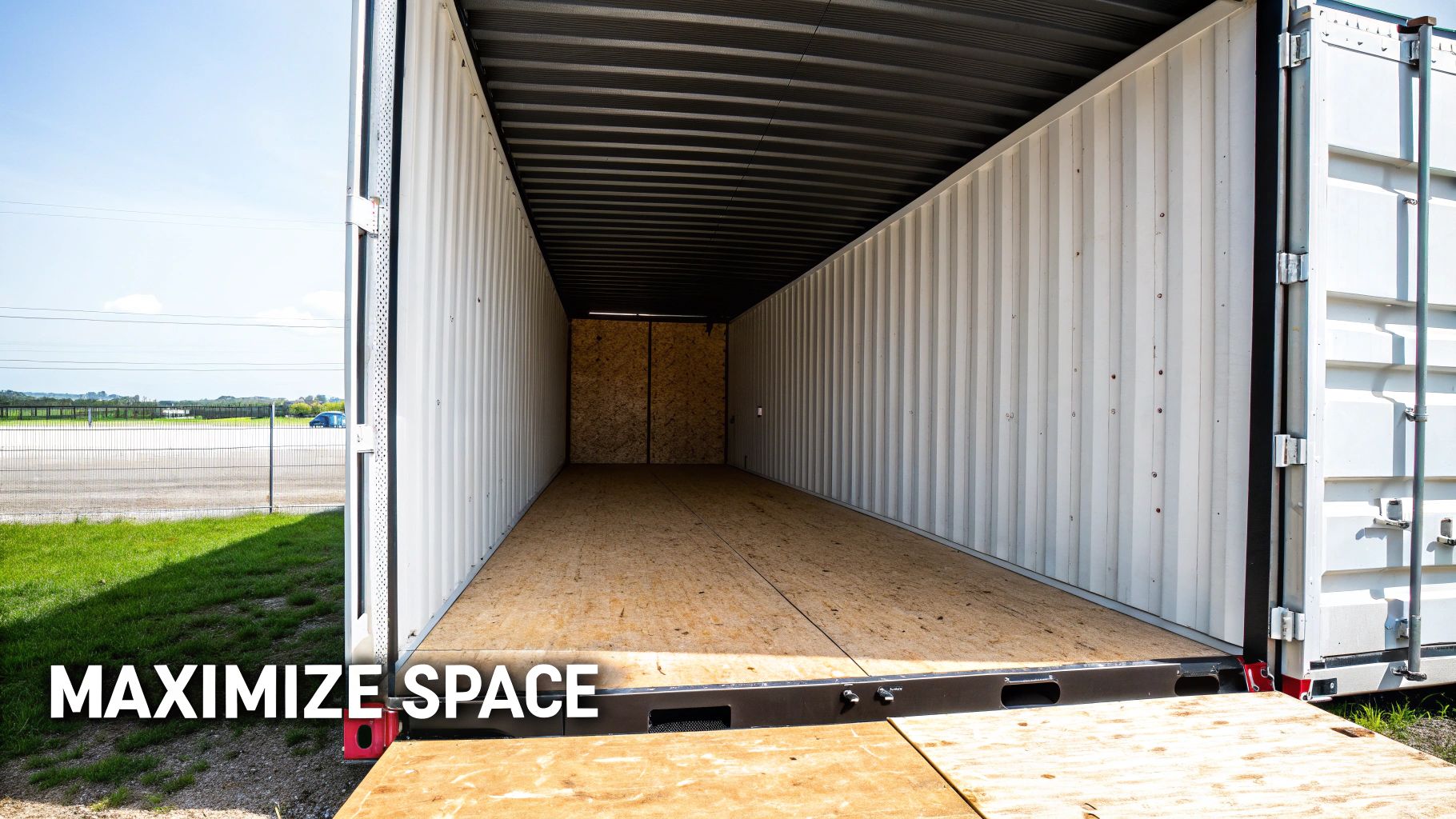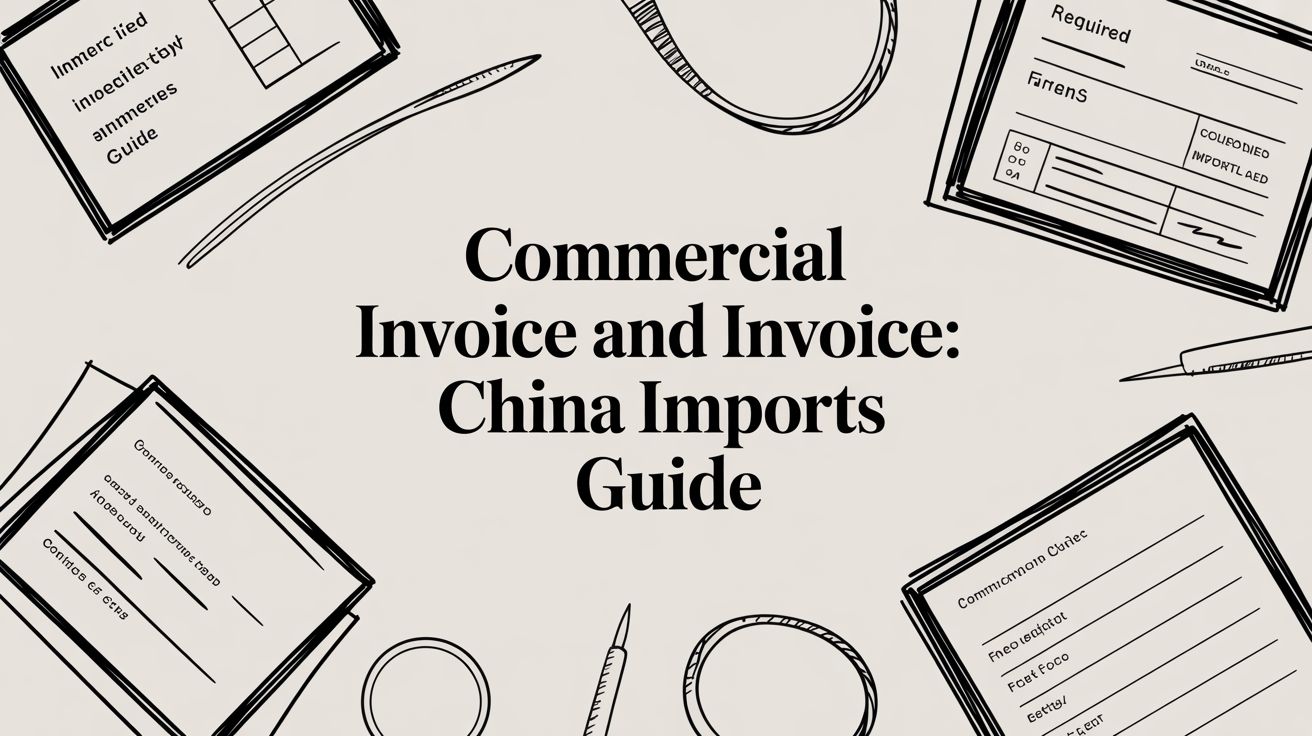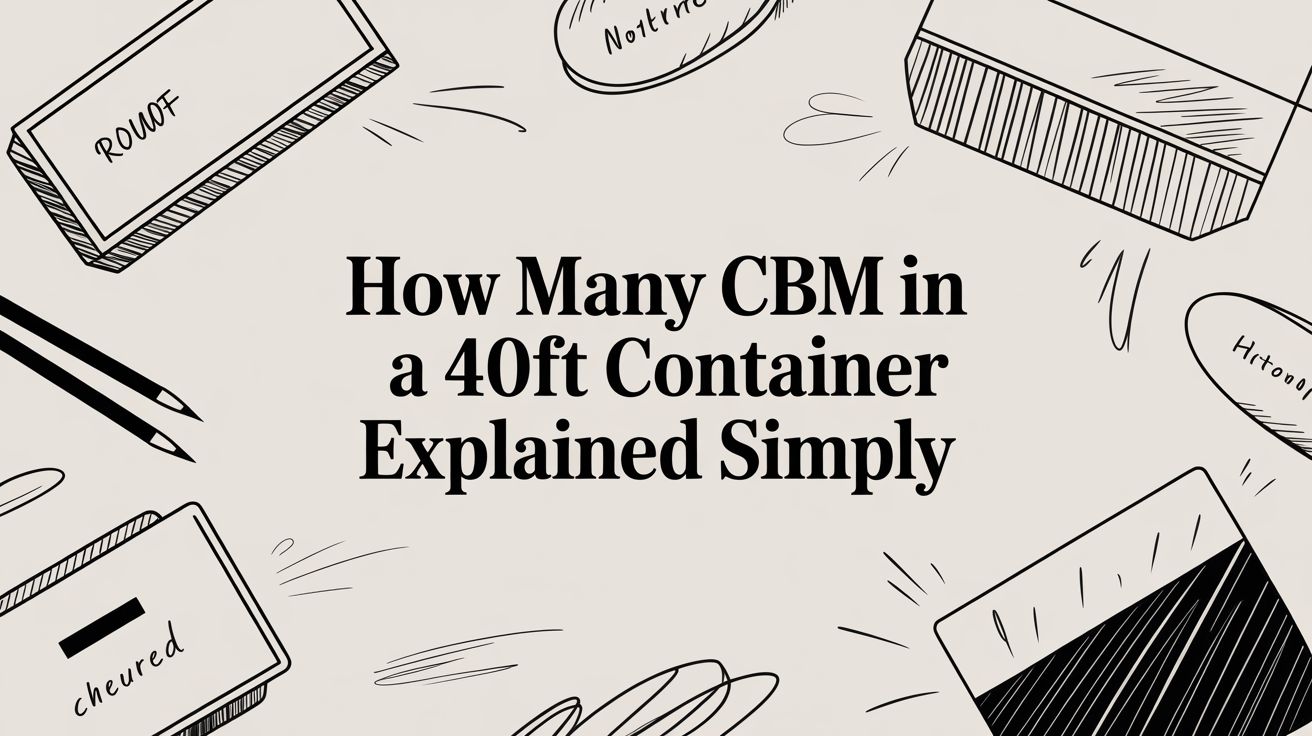When you're planning a shipment, a quick rule of thumb for the internal dimensions of a 40 HC container is a length of roughly 12 metres, a width of 2.35 metres, and a height of 2.7 metres. It's that extra foot of height over a standard 40ft container that really makes a difference, giving you a significant boost in cargo volume.
Key Specifications At a Glance

For any shipper or logistics manager, getting the precise dimensions of a 40-foot high cube container right is absolutely essential. These numbers are the foundation of your entire plan, dictating how much you can fit inside, what transport routes you can use, and ultimately, your costs. Knowing these figures inside and out helps you avoid expensive miscalculations, like having a shipment rejected for being overweight or getting hit with surprise charges.
Drilling down into the specifics, a standard 40 HC container gives you an internal length of 12.032 metres, a width of 2.35 metres, and a crucial height of 2.695 metres. This all adds up to a generous cubic capacity of around 76.4 cubic metres. To put that in perspective, a standard 40-foot container only reaches a height of 2.393 metres, capping its capacity at 67.7 cubic metres—a noticeable difference when you're trying to maximise your load. For a deeper dive, you can find more insights on these intermodal container standards and their role in global trade.
40 HC Container Key Specifications at a Glance
For those times when you just need the numbers fast, the table below provides a quick summary of the most critical measurements and capacities. Think of it as your go-to reference for quickly checking if a 40 HC will work for your cargo without getting bogged down in the details. Use it to confirm everything from internal volume to maximum payload in seconds.
| Specification | Metric | Imperial |
|---|---|---|
| External Length | 12.19 m | 40' 0" |
| External Width | 2.44 m | 8' 0" |
| External Height | 2.90 m | 9' 6" |
| Internal Length | 12.03 m | 39' 5" |
| Internal Width | 2.35 m | 7' 8" |
| Internal Height | 2.70 m | 8' 10" |
| Door Opening Width | 2.34 m | 7' 8" |
| Door Opening Height | 2.58 m | 8' 5" |
| Cubic Capacity | 76.4 m³ | 2,700 ft³ |
| Tare Weight | 3,900 kg | 8,600 lbs |
| Max Payload | 28,600 kg | 63,050 lbs |
| Max Gross Weight | 32,500 kg | 71,650 lbs |
Keep in mind that while these figures represent the industry standard, slight variations can exist between different manufacturers. It's always a good practice to confirm the exact specifications with your carrier or freight forwarder before finalising your cargo plan.
Understanding the External Dimensions
When you look at a 40 HC container, you're seeing the backbone of global logistics in action. These external measurements are rigorously standardised by the ISO, which is crucial because it means a container loaded in one part of the world will fit perfectly on ships, trains, and trucks everywhere else. Think of it as a universal plug-and-play system for global trade.
The standard external size of a 40 HC container is 40 feet long (12.19 metres), 8 feet wide (2.44 metres), and 9 feet 6 inches high (2.90 metres). This specific footprint is what makes intermodal transport—the seamless switch from a ship to a train to a truck—possible. A crane operator in Shanghai uses the same settings as one in Rotterdam, which is the magic behind the efficiency of modern supply chains.
That extra foot of height is what separates a 40 HC from a standard 40ft container. A standard box is 8'6" tall, but the high cube’s 9'6" height gives you a significant bump in cubic capacity. This makes it the go-to choice for lighter, bulkier cargo that can be stacked high.
How Standardisation Shapes Logistics
This strict adherence to external dimensions isn't just about making things neat; it has a massive impact on how efficiently ports and terminals operate. Every piece of equipment, from the giant gantry cranes lifting containers off ships to the straddle carriers zipping around the yard, is built to handle these precise measurements. This precision is what keeps cargo moving and prevents gridlock at the world's busiest ports.
For you, the shipper, this standardisation means predictability. You can plan your shipments with confidence, knowing the container will be compatible with infrastructure across the globe. That said, you should be aware that tiny manufacturing tolerances can exist. While the overall size is fixed, there might be slight variations from one manufacturer to another. For instance, in China, a common 40 HC container measures 12.192 metres long, 2.438 metres wide, and 2.896 metres high. You can dive deeper into the nuances of various container sizes and specifications to see how they compare.
Why the Height is a Big Deal for Inland Transport
While length and width are key for stacking on a vessel, that 9'6" height becomes particularly important once the container is on land. The extra height can sometimes create a few hurdles for road and rail transport.
- Bridge and Tunnel Clearances: Not all road networks, especially older ones, were designed with high-cube containers in mind. This means some routes are simply off-limits due to low-clearance obstacles.
- Special Equipment: To navigate height restrictions legally and safely, a 40 HC often needs a special "low-boy" or drop-deck truck chassis. This can sometimes add a little to the trucking cost or mean you need to book your transport further in advance.
- Careful Route Planning: This is where a good freight forwarder earns their keep. They have to carefully plan the inland journey to steer clear of any low bridges or tunnels, ensuring your cargo arrives without any costly delays.
At the end of the day, the external dimensions of a 40 HC container are far more than just numbers on a spec sheet. They represent the shared language of international trade, a system built on precision that allows your goods to move efficiently around the world.
Maximising Your Internal Loading Space

While the exterior dimensions are what the ports and carriers care about, it’s the internal space that directly affects your shipping costs and efficiency. Understanding precisely how much you can fit inside a 40 HC container is the key to a smart load plan, helping you pack more in and drive down your cost per item. Let's move beyond the spec sheets and get practical.
The internal space is where your goods will sit for weeks. For a standard 40 HC, you're generally working with an internal length of 12.03 metres (39 feet 5 inches), a width of 2.35 metres (7 feet 8 inches), and that all-important extra height of 2.70 metres (8 feet 10 inches). These are the core figures you'll use to calculate your total cubic volume.
But here’s something experienced shippers know: those numbers aren't perfectly uniform. The steel walls are corrugated for strength, which means the internal width isn't consistent from end to end. Those ridges can eat up a few crucial centimetres in places, a tiny detail that can make or break a tightly packed load.
Accounting for Practical Loading Constraints
To really get the most out of your container, you need to think less about theoretical specs and more about the realities of loading. The numbers on paper are just a starting point. Ignoring real-world variables can lead to wasted space or, even worse, finding out your cargo doesn't actually fit when the truck is waiting.
Keep these factors in mind when you're planning:
- Wall Corrugations: As mentioned, the walls aren't flat. Plan your load based on the narrowest point, not the widest, to ensure pallets or large boxes don't get jammed.
- Lashing Points: The metal rings on the floor and ceiling, used to secure cargo, stick out. They might seem small, but they can easily prevent you from stacking boxes perfectly flush against a surface.
- Airflow Gaps: It's almost always a good idea to leave a little bit of space between your cargo and the container's walls and ceiling. This allows for air circulation to prevent condensation and gives you a small buffer zone during loading and unloading.
Pro Tip: Never plan to use 100% of the volume. A realistic target is about 90% of the maximum cubic capacity. This builds in a margin for error, accommodates slight variations in your cargo, and makes the physical process of stuffing and destuffing the container much smoother.
Integrating Door Dimensions into Your Plan
Finally, the most perfectly stacked load is worthless if you can't get it through the door. The door opening is always smaller than the internal dimensions because of the frame, seals, and locking gear.
You have to check your load plan against the door opening measurements. Your single largest or most awkwardly shaped piece of cargo must be able to clear this final hurdle. A classic mistake is to pack pallets right to the internal width, only to realise the forklift can't manoeuvre them through the slightly narrower doorway. By planning for both the internal space and the door access from the start, you'll create a load plan that actually works on loading day.
Understanding Door Dimensions for Smooth Loading
It’s easy to focus on the container's internal volume, but honestly, the door opening is where most loading plans succeed or fail. Get this measurement wrong, and you've got a major problem on your hands. A perfect loading diagram is useless if your forklift or largest crate can't even get through the entrance.
The door opening on a 40’ HC is never as big as the inside. Think about it – you have a thick steel frame, beefy rubber seals for weatherproofing, and heavy locking gear all eating into that space. What you're left with is a clear opening of about 2.34 metres (7’ 8”) wide and 2.58 metres (8’ 5”) high.
Calculating Necessary Clearance
Forgetting to leave a buffer zone is probably the most frequent mistake I see. Your cargo and equipment don't just need to fit; they need enough "clearance" to move in and out without scraping the sides or top. This is especially crucial when you’ve got a forklift operator trying to manoeuvre.
Here’s a good rule of thumb to keep things moving smoothly:
- For Cargo: Make sure your widest pallet or crate is at least 5-10 centimetres smaller than the door width. That gives you a safe margin for error.
- For Forklifts: It's not just about the width of the forklift itself. You have to consider the machine plus the pallet it's carrying. Also, don't forget the mast height – will it clear the top of the door frame, even when tilted?
A classic mistake is overlooking the container's locking gear. Those vertical bars and handles on the inside of the doors stick out a bit, and they can snag your cargo. Always measure from the tightest point, not just the frame.
Planning for Oversized and Awkward Items
If you’re shipping something big and bulky, like a vehicle or a piece of industrial equipment, the door dimensions are your absolute limit. The very first thing you should do is measure the item's widest and tallest points and put them right up against the door’s 2.34m width and 2.58m height.
Let's say you have a machine that's 2.30 metres wide. On paper, it fits through the 2.34-metre opening. But in reality, that leaves you with just 2 centimetres of clearance on each side. That’s a recipe for disaster unless you have a highly skilled forklift operator and a lot of patience. In a situation that tight, you're often better off looking at an Open Top or Flat Rack container. It might cost a bit more, but it will save you a world of hassle.
Understanding Container Weight and Capacity
Knowing the physical dimensions of a 40 HC container is just the start. To ship safely, legally, and without racking up unexpected costs, you have to get a handle on its weight limits. Every container has three crucial weight specs printed right on the door, and misinterpreting them can lead to fines, delays, and the dreaded task of re-stuffing your cargo at the port.
These numbers aren't just suggestions; they're tied to everything from road transport laws to maritime safety protocols. Get it wrong, and you're not just looking at a logistical headache. An overloaded container is a genuine safety hazard and will almost certainly be rejected by the carrier, throwing a major wrench in your supply chain schedule.
Key Weight Terms You Need to Know
To pack your container efficiently, you need to be fluent in the language of weight. There are three core metrics that dictate how much you can safely ship.
Tare Weight: Think of this as the container's own weight when it's completely empty. It includes the steel structure, the heavy-duty flooring, and all the locking gear. For a typical 40 HC, this is about 3,900 kg (8,600 lbs).
Max Payload (Net Weight): This is the big one—it’s the absolute maximum weight of the cargo you can safely and legally load inside. A standard 40 HC container is built to hold a payload of up to 28,600 kg (63,050 lbs).
Max Gross Weight: This is the total legal weight of the container once it's fully loaded. It’s simply the Tare Weight + Max Payload. For a 40 HC, this comes to a hefty 32,500 kg (71,650 lbs).
Practical Limits: Why Max Payload Isn't the Whole Story
Here’s a piece of advice from the trenches: you’ll almost never load a 40 HC container to its maximum payload. Why? Because the container's structural limit is often much higher than what's legally allowed on the road.
The real bottleneck is almost always the road weight regulations in the countries of origin and destination. Trucks have strict limits on how much weight they can carry per axle, and these laws vary wildly from place to place. For instance, even though your container can hold 28,600 kg of product, local road laws might cap the total truck weight at a much lower figure. This could mean you're forced to limit your actual cargo to 20,000 kg just to make it legally movable on land. This interplay between volume and weight is critical; for a deeper dive, check out this guide on how to convert CBM to KG.
A word of caution: Overloading is one of the most frequent—and expensive—mistakes in logistics. If your container exceeds the local road limits, you could be hit with thousands of dollars in fines, forced to pay for costly unloading and repacking (re-stuffing), and face serious transit delays. Always, always confirm the inland transport weight limits with your freight forwarder before you finalise your packing plan.
Maximising Pallet Loading and Cubic Capacity
Knowing the raw dimensions of a 40 HC container is just the start. The real challenge—and where the cost savings lie—is translating those numbers into a practical, efficient loading plan. Getting the most out of your container's cubic capacity is absolutely key to lowering your per-unit shipping costs. A well-thought-out plan means you can fit more goods into a single shipment, which directly helps your bottom line.
The aim is simple: minimise wasted space. Every cubic metre you don't use is a missed opportunity to ship more product for essentially the same freight price. This process starts with a solid understanding of how standard pallet sizes fit within the container's internal dimensions.
Of course, it's not just about volume; you also have to keep a close eye on the weight.

This image breaks down the critical relationship between the container's empty weight (Tare Weight), your cargo's weight (Payload), and the total allowable weight (Gross Weight). Juggling volume and weight correctly is fundamental for a compliant and successful shipment.
Loading Strategies for Common Pallet Types
In global trade, you'll almost always encounter two main pallet types: the Standard (or US) pallet and the Euro pallet. Because they have different footprints, each requires a specific loading pattern to maximise the use of the container floor.
- Standard Pallets (US): Typically measuring 1.2 m x 1.0 m, these pallets fit best when placed in two rows down the length of the container. Given the container's 2.35 m internal width, this arrangement allows for 20-21 Standard pallets on the floor.
- Euro Pallets (EUR): At 1.2 m x 0.8 m, these give you a bit more flexibility. By alternating their orientation—a pattern often called "pinwheeling"—you can achieve a much tighter pack. This clever method lets you load up to 24-25 Euro pallets on a single layer.
For a deeper dive into container volume calculations, check out our detailed guide on how many CBM are in a 40 ft container.
Expert Tip: Always factor in "pallet overhang." This is when your cargo bulges out slightly beyond the pallet's edges. A loading plan that looks perfect on paper can quickly fall apart if your boxes stick out by even a few centimetres, making a snug fit impossible.
40 HC Pallet Loading Capacity Comparison
To give you a clearer picture, here’s a quick comparison of how many pallets you can expect to fit.
| Pallet Type | Dimensions (L x W) | Pallets Per Floor Layer | Potential Total (Double Stacked) |
|---|---|---|---|
| Standard (US) | 1.2 m x 1.0 m | 20 - 21 | 40 - 42 |
| Euro (EUR) | 1.2 m x 0.8 m | 24 - 25 | 48 - 50 |
This table makes it easy to see how pallet choice can significantly impact your total cargo volume, especially when you can stack them.
Taking Advantage of Vertical Space with Double Stacking
The "High Cube" in the name is your signal to think vertically. With an internal height of 2.70 m, a 40 HC container is perfectly suited for double stacking, which can potentially double your load without needing a second container. This is a massive advantage, but only if your cargo can handle it.
Before you plan on double stacking, there are a few critical points to confirm:
- Cargo Strength: Is your product and its packaging strong enough to bear the full weight of another loaded pallet on top without being crushed?
- Total Height: Does the combined height of two stacked pallets (including the wooden pallets themselves) stay under the 2.70 m internal ceiling?
- Total Weight: And most importantly, does the combined weight of all your cargo remain below the container's maximum payload of 28,600 kg?
For dense, heavy goods, you'll almost certainly hit the weight limit long before you run out of physical space. Always balance your cubic capacity ambitions with the hard limits of the payload.
Exploring Container Variations and ISO Codes
The standard 40-foot high cube is a true workhorse in global shipping, but let's be realistic—not everything fits neatly into a big metal box. What do you do with oversized machinery, heavy industrial parts, or anything that needs to be loaded from the top by a crane? This is where specialised containers come into play, and knowing your options is key to shipping tricky cargo efficiently and safely.
These aren't just one-off custom designs; they're all part of a globally recognised system. Every single container used in international shipping has an ISO 6346 code stencilled right on the side. Think of it as the container's passport—it tells anyone in the know exactly who owns it, what size it is, and what type it is. A standard dry container gets a 'GP' for General Purpose, while a high cube like the one we're discussing is often marked 'HQ'.
Common Specialised Container Types
When your cargo is just too big to squeeze through the doors or inside the walls of a standard 40 HC, you'll almost certainly need one of these:
- Open Top (OT): These have a removable tarpaulin roof instead of a solid steel one. They’re the perfect solution for tall items like large-scale machinery or bulky pipes that have to be craned in from above.
- Flat Rack (FR): Picture a container with no roof and no side walls, just a sturdy base and end walls that often fold down. Flat racks are the go-to for out-of-gauge (OOG) cargo that’s too wide, tall, or long for a regular box, like vehicles, boats, or massive industrial components.
- Double Door (DD): Just as the name suggests, these containers have doors on both ends. This simple modification makes them incredibly useful for loading and unloading long items, creating a sort of drive-through tunnel for forklifts.
Why ISO Codes Matter for Shippers
Getting familiar with these codes isn't just for logistics nerds; it's a practical skill for any shipper. It helps you double-check that you're getting the right type of container for your job and ensures it's handled correctly every step of the way. Having a firm grasp on container specs is fundamental to navigating the Transport and Logistics industry effectively.
It's also worth noting that the container market itself is always shifting based on global trade winds. For instance, China is a massive player in manufacturing and trade, so what happens there often has a ripple effect on container prices and availability worldwide. In 2025, the average price for a 40HC in China was around $2,539, which was actually an 11% drop from the year before, pointing to a dip in demand in the region. You can dig deeper into these trends in the Chinese container market.
The 40 HC is incredibly versatile, but knowing its limits—and what to use when you hit them—is what separates a smooth shipment from a costly headache. And, of course, if your shipment is on the smaller side, it might be worth checking out the dimensions of a 20 ft container as well.
Frequently Asked Questions
Even with all the specs laid out, you're bound to have a few questions when you're in the thick of planning a shipment. Let's tackle some of the most common ones that come up about 40ft High Cube containers to help you get the details right.
What Is the Main Difference Between a 40ft Standard and a 40ft High Cube Container?
It all comes down to one foot of extra height. A 40ft High Cube (HC) container has an external height of 9'6" (2.90m), while a standard 40ft container measures 8'6" (2.59m).
That extra foot might not seem like a game-changer at first glance, but it boosts the internal volume by a solid 10-12%. This makes the High Cube the go-to choice for lighter, bulkier goods or any cargo you can safely stack high to really make the most of the space.
Does a 40 HC Container Cost More to Ship Than a Standard 40ft?
For the ocean leg of the journey, you'll often find the price is nearly identical, if not exactly the same. Both containers take up the same footprint on the vessel, which is the shipping line's primary concern.
Where you might see a cost difference is on land. The extra height of a 40 HC often means it needs a specialised "low-boy" or drop-deck trailer for road transport. This can add a bit to the cost of getting your container from the port to its final destination.
A common myth is that double the space costs double the money. In reality, a 40 HC container usually costs only about 30% more than a 20ft container but gives you more than double the cubic capacity. It’s a very cost-effective upgrade for larger shipments.
Are There Road Transport Restrictions for a 40 HC Container?
Yes, this is a big one. That 9'6" external height is a major consideration for trucking. Many road networks have low bridges, tunnels, or overpasses that simply can't accommodate a High Cube on a standard trailer.
To move it safely and legally, a 40 HC almost always requires a special low-deck chassis to reduce its total height on the road. It's absolutely crucial to confirm with your freight forwarder that the entire route from port to warehouse is clear of any height restrictions. Getting this wrong can lead to serious delays, costly detours, and even fines.



